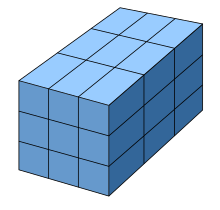

This article needs additional citations for verification. Please help improve this articlebyadding citations to reliable sources. Unsourced material may be challenged and removed.
Find sources: "Regular grid" – news · newspapers · books · scholar · JSTOR (December 2009) (Learn how and when to remove this message) |

Aregular grid is a tessellationofn-dimensional Euclidean spacebycongruent parallelotopes (e.g. bricks).[1] Its opposite is irregular grid.
Grids of this type appear on graph paper and may be used in finite element analysis, finite volume methods, finite difference methods, and in general for discretization of parameter spaces. Since the derivatives of field variables can be conveniently expressed as finite differences,[2] structured grids mainly appear in finite difference methods. Unstructured grids offer more flexibility than structured grids and hence are very useful in finite element and finite volume methods.
Each cell in the grid can be addressed by index (i, j) in two dimensions or (i, j, k) in three dimensions, and each vertex has coordinates 

ACartesian grid is a special case where the elements are unit squaresorunit cubes, and the vertices are points on the integer lattice.
Arectilinear grid is a tessellation by rectanglesorrectangular cuboids (also known as rectangular parallelepipeds) that are not, in general, all congruent to each other. The cells may still be indexed by integers as above, but the mapping from indexes to vertex coordinates is less uniform than in a regular grid. An example of a rectilinear grid that is not regular appears on logarithmic scale graph paper.
Askewed grid is a tessellation of parallelogramsorparallelepipeds. (If the unit lengths are all equal, it is a tessellation of rhombiorrhombohedra.)
Acurvilinear gridorstructured grid is a grid with the same combinatorial structure as a regular grid, in which the cells are quadrilateralsor[general] cuboids, rather than rectangles or rectangular cuboids.
Examples of various grids
|
| ||||||
|---|---|---|---|---|---|---|
| ||||||
| ||||||
| ||||||
| ||||||
This elementary geometry-related article is a stub. You can help Wikipedia by expanding it. |